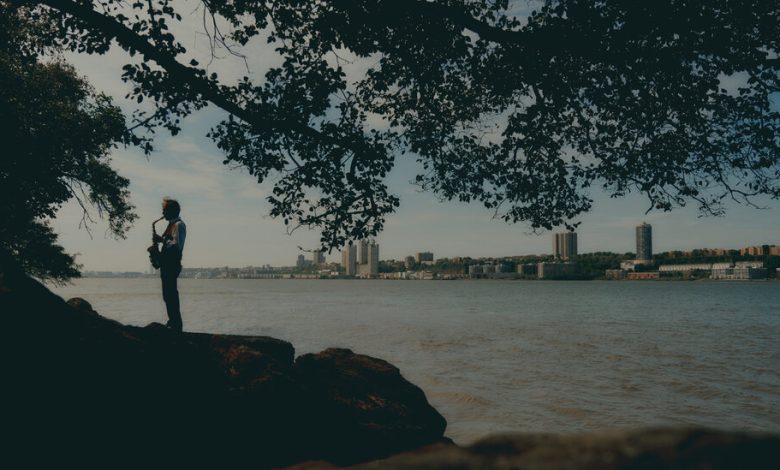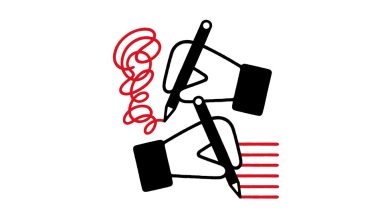I Started Playing My Sax Outdoors. Then the Fans Came.

It was Year 2 of the pandemic, in the spring, that I hit on the idea of having my high school saxophone refurbished. My 48-year-old horn came back from the repair shop in Midtown Manhattan a week later. I put it together in my Upper West Side apartment and … for the love of God, it was loud. A couple of days later, I saw my downstairs neighbor in the lobby, and he asked, “Is that a sax I hear?” He professed to be OK with my rudimentary jazz stylings, but I was uncomfortable.
My building is directly adjacent to Riverside Park. The day after that encounter, I walked 10 minutes down to the bank of the Hudson, found an arrangement of boulders where I could put my case and started to improvise to some 1960s soul jazz playing through my headphones. I was loud. Gloriously, triumphantly loud. Within minutes, bike riders and strolling couples stopped to listen. Some took photos. After that, I took my sax to the park almost every day. Over the next few weeks and on through this summer, paddleboarders, canoers and motorboats on the river hove to the shore to listen for a few minutes. When the traffic on the nearby West Side Highway ground to a halt, I got a round of applause. I had at least two cameos on Instagram.
I find it hard to practice inside now, even in my building, where the jazz pianist and composer Billy Strayhorn once lived. It’s inhibiting. I miss the expansiveness of playing outside. And I’ve found nature surprisingly attentive, despite the noise. Robins and sparrows — and only one word is possible here — flock to me as if I’m St. Francis of C Minor. Squirrels stand on their hind legs and fix me with hard stares, like miniature critics. My most cherished fan, though, was Zippy, a goose with whom I had a prior relationship. (My wife is known as the Goose Lady of Riverside Park, but that’s a subject for another essay.) One summer day, Zippy and his extended family were paddling south down the Hudson but then circled back and flew up to the riverbank next to me. Zippy sat there quietly for the next 45 minutes until I packed up to head home. There is nothing more satisfying than entertaining a goose you’re fond of.
But, of course, it’s the interactions with people that mean the most. Little kids in matching T-shirts on day-camp outings are delighted. They clap for the noisy man. The guy with the wild hair, eating a sandwich on a nearby bench, loved it too. “Do you know Hall and Oates?” he asked. “You should learn ‘Maneater.’ You could make a lot of dough playing that. Hey, if you need some grub, that church on 99th is pretty good.” I wasn’t sure if I looked like I could use a square meal or just sounded like it.
To be honest, I stink. This is not humble-bragging. I’m just realistic about my abilities. I imagine that for many people, what I’m playing sounds “jazzy.” (Common questions from passers-by: “Are you professional?” “Do you play in a club someplace?”) But if I showed up at Smalls, the Greenwich Village jazz spot, for one of their jam sessions, and someone said, “Let’s do ‘How High the Moon’ in D flat,” it wouldn’t take more than a few measures for the drummer to toss one of his cymbals at me. (It happened to Charlie Parker in Kansas City in the 1930s, although he went on to great things.) I’m OK with simple chord progressions or, better yet, just wailing to a Jimmy Smith recording. But I still can’t throw in those diminished-seventh licks or tritone substitutions at will. It’s shocking, really, how little I have progressed since fourth grade. I don’t care. When I play outdoors, perfection is neither possible nor expected.
In 1960, Sonny Rollins, already one of the greatest tenor-sax players ever, quit recording and appearing in public so he could concentrate on getting better. He was living on the Lower East Side. He tried to practice in a closet (I’ve been there). Still too loud. There was a pregnant neighbor. “I felt real guilty,” he said, according to a 2022 biography. So he walked over to the Williamsburg Bridge and played outside day and night until he returned two years later with an LP called “The Bridge.” I’m not Sonny Rollins, but I can hear progress.
I can be pretty jumpy in public. It’s New York: You pay attention (and a sax is not cheap). I was playing a few weeks ago at another spot I like, just off the main path that runs through the upper park. My sax case and music were on a stone wall. At some point, I noticed a man squatting a few feet behind me, fumbling through some kind of bag. I thought, Here we go! He stood up and lurched over to me, his hand raised. And then he said, “Do you want me to put it there?” indicating my open case. He had a few coins in his hand. This guy wasn’t in good shape — maybe under the influence of something, maybe just struggling with life — but he wanted to share what he had.
I said: “That’s really nice of you, but I’m just practicing. Keep that for yourself.”
“You sure?”
“Yeah, I’m sure.” I did two taps on my heart.
“I love what you’re doing,” he said, quite emotionally. He gave me a soul shake and then brought me in for a bro hug. “I love you, man.”
“I love you too, man,” I said.
Really, what I should do is go to the park with a case full of dollar bills and pass them out to the people (and geese) who stop to listen, because I owe them for a music lesson I didn’t know I needed.
Harvey Dickson has been a staff editor at The Times since 1997, for the last 16 years at the magazine. He has also worked at The International Herald Tribune in Paris.



